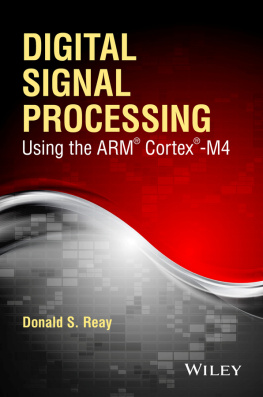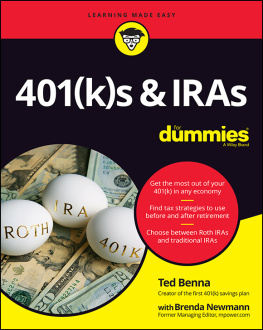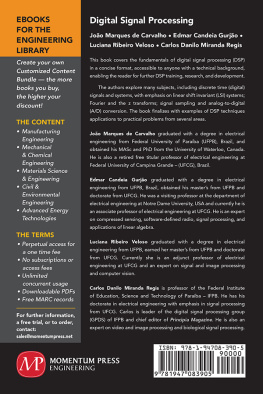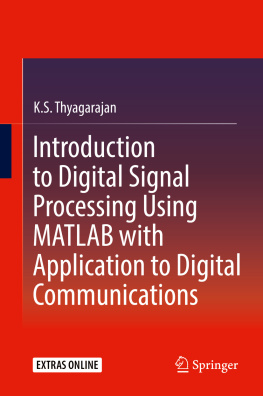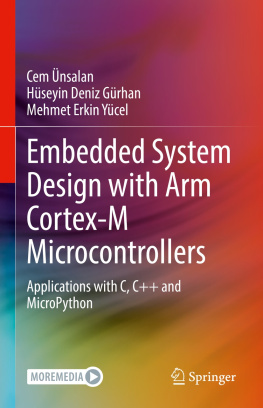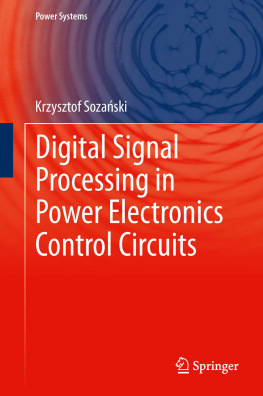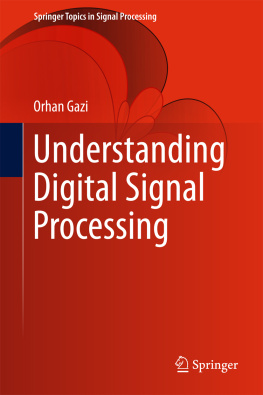John Wiley - Digital Signal Processing and Applications Using the ARM Cortex M4
Here you can read online John Wiley - Digital Signal Processing and Applications Using the ARM Cortex M4 full text of the book (entire story) in english for free. Download pdf and epub, get meaning, cover and reviews about this ebook. City: Hoboken;NJ, year: 2016;2015, publisher: John Wiley & Sons, Incorporated, genre: Computer. Description of the work, (preface) as well as reviews are available. Best literature library LitArk.com created for fans of good reading and offers a wide selection of genres:
Romance novel
Science fiction
Adventure
Detective
Science
History
Home and family
Prose
Art
Politics
Computer
Non-fiction
Religion
Business
Children
Humor
Choose a favorite category and find really read worthwhile books. Enjoy immersion in the world of imagination, feel the emotions of the characters or learn something new for yourself, make an fascinating discovery.
- Book:Digital Signal Processing and Applications Using the ARM Cortex M4
- Author:
- Publisher:John Wiley & Sons, Incorporated
- Genre:
- Year:2016;2015
- City:Hoboken;NJ
- Rating:4 / 5
- Favourites:Add to favourites
- Your mark:
- 80
- 1
- 2
- 3
- 4
- 5
Digital Signal Processing and Applications Using the ARM Cortex M4: summary, description and annotation
We offer to read an annotation, description, summary or preface (depends on what the author of the book "Digital Signal Processing and Applications Using the ARM Cortex M4" wrote himself). If you haven't found the necessary information about the book — write in the comments, we will try to find it.
Digital Signal Processing and Applications Using the ARM Cortex M4 — read online for free the complete book (whole text) full work
Below is the text of the book, divided by pages. System saving the place of the last page read, allows you to conveniently read the book "Digital Signal Processing and Applications Using the ARM Cortex M4" online for free, without having to search again every time where you left off. Put a bookmark, and you can go to the page where you finished reading at any time.
Font size:
Interval:
Bookmark:

Copyright 2016 by John Wiley & Sons, Inc. All rights reserved
Published by John Wiley & Sons, Inc., Hoboken, New Jersey
Published simultaneously in Canada
ARM and Cortex are registered trademarks of ARM Limited (or its subsidiaries) in the EU and/or elsewhere. All rights reserved.
MATLAB and Simulink are registered trademarks of The MathWorks, Inc. See www.mathworks.com/ trademarks for a list of additional trademarks. The MathWorks Publisher Logo identifies books that contain MATLAB content. Used with Permission. The book's or downloadable software's use of discussion of MATLAB software or related products does not constitute endorsement or sponsorship by the MathWorks of a particular use of the MATLAB software or related products.
For MATLAB product information, or information on other related products, please contact:
The MathWorks, Inc., 3 Apple Hill Drive, Natick. MA 01760-2098 USA, Tel: 508-647-7000, Fax: 508-647-7001, E-mail:
No part of this publication may be reproduced, stored in a retrieval system, or transmitted in any form or by any means, electronic, mechanical, photocopying, recording, scanning, or otherwise, except as permitted under Section 107 or 108 of the 1976 United States Copyright Act, without either the prior written permission of the Publisher, or authorization through payment of the appropriate per-copy fee to the Copyright Clearance Center, Inc., 222 Rosewood Drive, Danvers, MA 01923, (978) 750-8400, fax (978) 750-4470, or on the web at www.copyright.com. Requests to the Publisher for permission should be addressed to the Permissions Department, John Wiley & Sons, Inc., 111 River Street, Hoboken, NJ 07030, (201) 748-6011, fax (201) 748-6008, or online at http://www.wiley.com/go/permissions.
Limit of Liability/Disclaimer of Warranty: While the publisher and author have used their best efforts in preparing this book, they make no representations or warranties with respect to the accuracy or completeness of the contents of this book and specifically disclaim any implied warranties of merchantability or fitness for a particular purpose. No warranty may be created or extended by sales representatives or written sales materials. The advice and strategies contained herein may not be suitable for your situation. You should consult with a professional where appropriate. Neither the publisher nor author shall be liable for any loss of profit or any other commercial damages, including but not limited to special, incidental, consequential, or other damages.
For general information on our other products and services or for technical support, please contact our Customer Care Department within the United States at (800) 762-2974, outside the United States at (317) 572-3993 or fax (317) 572-4002.
Wiley also publishes its books in a variety of electronic formats. Some content that appears in print may not be available in electronic formats. For more information about Wiley products, visit our web site at www.wiley.com.
Library of Congress Cataloging-in-Publication Data:
Reay, Donald (Donald S.), author.
Digital signal processing using the ARM Cortex-M4 / Donald Reay.
pages cm
Includes bibliographical references and index.
ISBN 978-1-118-85904-9 (pbk.)
1. Signal processingDigital techniques. 2. ARM microprocessors. I. Title.
TK5102.9.R4326 2015
621.3822dc23
2015024771
To Reiko
This book continues the series started in 1990 by Rulph Chassaing and Darrell Horning's Digital Signal Processing with the TMS320C25, which tracked the development of successive generations of digital signal processors by Texas Instruments. More specifically, each book in the series up until now has complemented a different inexpensive DSP development kit promoted for teaching purposes by the Texas Instruments University Program. A consistent theme in the books has been the provision of a large number of simple example programs illustrating DSP concepts in real time, in an electrical engineering laboratory setting.
It was Rulph Chassaing's belief, and this author continues to believe, that hands-on teaching of DSP, using hardware development kits and laboratory test equipment to process analog audio frequency signals, is a valuable and effective way of reinforcing the theory taught in lectures.
The contents of the books, insofar as they concern fundamental concepts of digital signal processing such as analog-to-digital and digital-to-analog conversion, finite impulse response (FIR) and infinite impulse response (IIR) filtering, the Fourier transform, and adaptive filtering, have changed little. Every academic year brings another cohort of students wanting to study this material. However, each book has featured a different DSP development kit.
In 2013, Robert Owen suggested to me that hands-on DSP teaching could be implemented using an inexpensive ARM Cortex-M4 microcontroller. I pointed out that a Texas Instruments C674x processor was very significantly more computationally powerful than an ARM Cortex-M4. But I also went ahead and purchased a Texas Instruments Stellaris LaunchPad. I constructed an audio interface using a Wolfson WM8731 codec and successfully ported the program examples from my previous book to that hardware platform.
This book is aimed at senior undergraduate and postgraduate electrical engineering students who have some knowledge of C programming and linear systems theory, but it is intended, and hoped, that it may serve as a useful resource for anyone involved in teaching or learning DSP and as a starting point for teaching or learning more.
I am grateful to Robert Owen for first making me aware of the ARM Cortex-M4; to Khaled Benkrid at the ARM University Program and to the Royal Academy of Engineering for making possible a six-month Industrial Secondment to ARM during which teaching materials for the STM32f01 platform were developed; to Gordon McLeod and Scott Hendry at Wolfson Microelectronics for their help in getting the Wolfson Pi audio card to work with the STM32f01 Discovery; to Sean Hong, Karthik Shivashankar, and Robert Iannello at ARM for all their help; to Joan Teixidor Buixeda for helping to debug the program examples; to Cathy Wicks at the TI University Program and Hieu Duong at CircuitCo for developing the audio booster pack; and to Kari Capone and Brett Kurzman at Wiley for their patience. But above all, I thank Rulph Chassaing for inspiring me to get involved in teaching hands-on DSP.
Donald S. Reay
Edinburgh
2015
ARM CORTEX-M4 Development Systems
Traditionally, real-time digital signal processing (DSP) has been implemented using specialized and relatively expensive hardware, for example, digital signal processors or field-programmable gate arrays (FPGAs). The ARM Cortex-M4 processor makes it possible to process audio in real time (for teaching purposes, at least) using significantly less expensive, and simpler, microcontrollers.
The ARM Cortex-M4 is a 32-bit microcontroller. Essentially, it is an ARM Cortex-M3 microcontroller that has been enhanced by the addition of DSP and single instruction multiple data (SIMD) instructions and (optionally) a hardware floating-point unit (FPU). Although its computational power is a fraction of that of a floating-point digital signal processor, for example, the Texas Instruments C674x, it is quite capable of implementing DSP algorithms, for example, FIR and IIR filters and fast Fourier transforms for audio signals in real-time.
A number of semiconductor manufacturers have developed microcontrollers that are based on the ARM Cortex-M4 processor and that incorporate proprietary peripheral interfaces and other IP blocks. Many of these semiconductor manufacturers make available very-low-cost evaluation boards for their ARM Cortex-M4 microcontrollers. Implementing real-time audio frequency example programs on these platforms, rather than on more conventional DSP development kits, constitutes a reduction of an order of magnitude in the hardware cost of implementing hands-on DSP teaching. For the first time, students might realistically be expected to own a hardware platform that is useful not only for general microcontroller/microprocessor programming and interfacing activities but also for implementation of real-time DSP.
Next pageFont size:
Interval:
Bookmark:
Similar books «Digital Signal Processing and Applications Using the ARM Cortex M4»
Look at similar books to Digital Signal Processing and Applications Using the ARM Cortex M4. We have selected literature similar in name and meaning in the hope of providing readers with more options to find new, interesting, not yet read works.
Discussion, reviews of the book Digital Signal Processing and Applications Using the ARM Cortex M4 and just readers' own opinions. Leave your comments, write what you think about the work, its meaning or the main characters. Specify what exactly you liked and what you didn't like, and why you think so.

